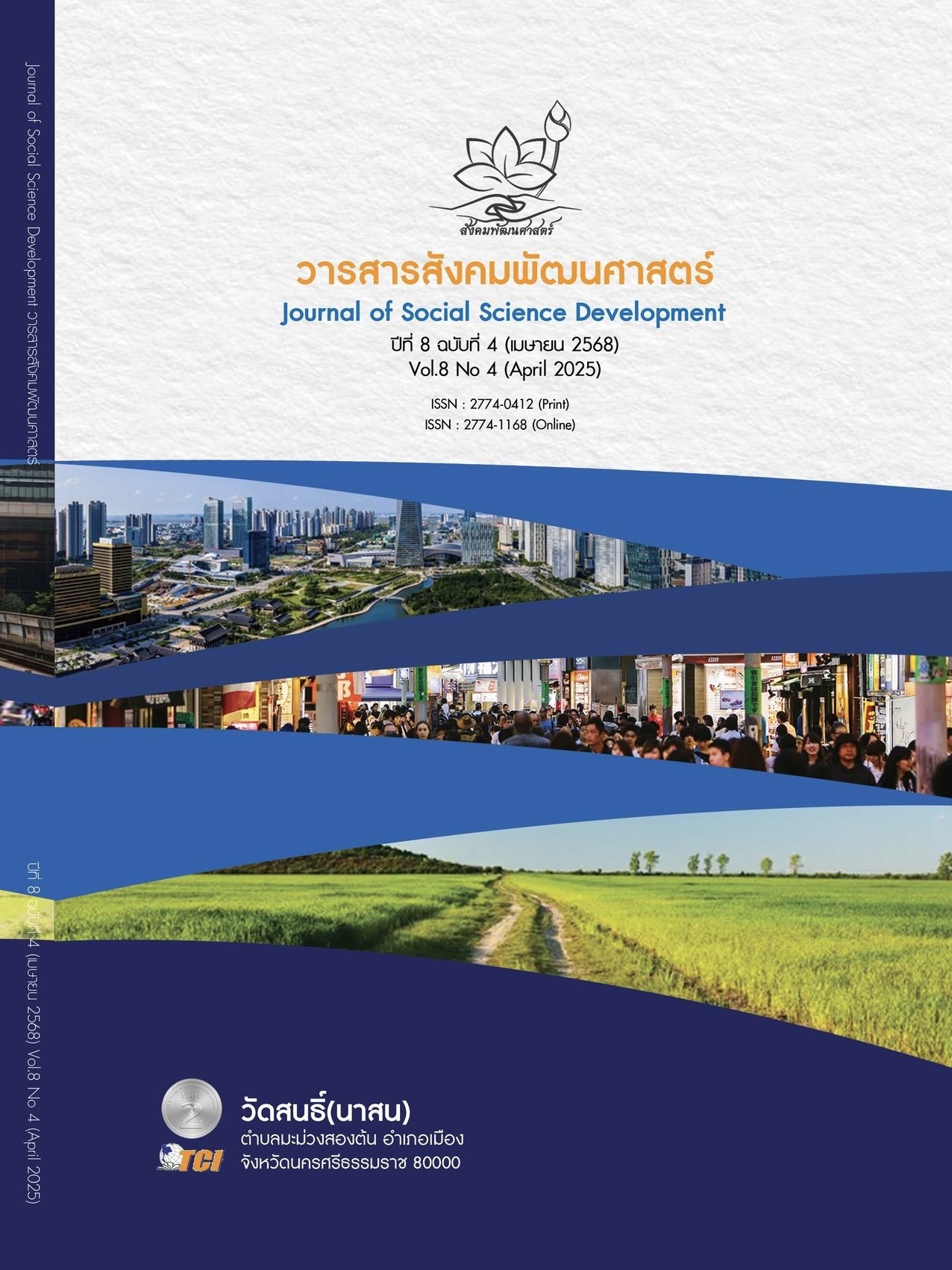MARKETING STRATEGY DEVELOPMENT FOR CREATIVE TOURISM IN PAKBARA COMMUNITY
Main Article Content
Abstract
This research uses qualitative research methodology to develop marketing strategies for creative tourism in the Pak Bara community, Satun Province. The study was conducted in three villages within the Pak Bara community, involving 20 key informants selected based on their experience in local tourism management. Research instruments included semi-structured interviews and field notes. Instrument quality was validated through content validity assessment conducted by three experts. Data were analyzed using content analysis by grouping information according to key themes and summarizing the findings. The findings indicated that creative tourism is well-suited to niche markets, especially Thai tourists from the five southern border provinces, and the marketing strategies employed were based on 4P’s marketing mix, as follows: 1) Product Strategy: Focuses on developing tourism programs that emphasize experiential learning and community engagement to create differentiation. 2) Pricing Strategy: Emphasizes value-based pricing and demand flexibility, with price control measures and discounts based on seasonality, volume, and cash payment. 3) Distribution Strategy: Improve the efficiency of existing distribution channels, including direct sales through 14 community enterprises and intermediaries, utilizing digital platforms and 4) Promotion Strategy: Implement integrated marketing communications to improve communication effectiveness and reach target groups. This includes advertising, public relations, sales promotions, personal selling, and word-of-mouth marketing to create positive impressions and encourage referrals through digital platforms. The marketing strategies derived from this research can enhance the development of creative tourism in the Pak Bara community, and effectively respond to the needs of target tourists. Enhance the competitive potential of Pak Bara’s creative tourism.
Article Details

This work is licensed under a Creative Commons Attribution-NonCommercial-NoDerivatives 4.0 International License.
References
กรมการท่องเที่ยว. (2560). คู่มือการบริหารจัดการแหล่งท่องเที่ยวเชิงสร้างสรรค์. เรียกใช้เมื่อ 1 กุมภาพันธ์ 2568 จาก https://www.dot.go.th/news/internal-audit-plan/detail/3052/8
เจ้าหน้าที่ภาครัฐคนที่ 3. (15 ต.ค. 2564). การพัฒนากลยุทธ์การตลาดท่องเที่ยวเชิงสร้างสรรค์ชุมชนปากบารา. (ธีรพร ทองขะโชค, ผู้สัมภาษณ์)
ชาย โพธิสิตา. (2564). ศาสตร์และศิลป์การวิจัยเชิงคุณภาพ: คู่มือนักศึกษาและนักวิจัยสังคมศาสตร์. (พิมพ์ครั้งที่ 9). กรุงเทพมหานคร: อมรินทร์พริ้นติ้งแอนด์พับลิชชิ่ง.
ณรงค์ พลีรักษ์ และคณะ. (2559). โครงการการท่องเที่ยวเชิงสร้างสรรค์ตามแนวบูรพาทิศ. ชลบุรี: คณะภูมิสารสนเทศ มหาวิทยาลัยบูรพา.
ดนุวัศ สุวรรณวงศ์. (2564). แนวทางการพัฒนาตลาดการท่องเที่ยวอุทยานธรณีโลกสตูลเพื่อยกระดับการพัฒนาพื้นที่จังหวัดสตูลภายใต้ความร่วมมือของหน่วยงานภาครัฐและภาคเอกชน. วารสารมนุษยศาสตร์และสังคมศาสตร์มหาวิทยาลัยนครพนม, 11(1), 261-273.
ตรีฤกษ์ เพชรมนต์ และคณะ. (2564). กลยุทธ์ด้านการตลาดของการท่องเที่ยวเชิงนิเวศและผจญภัย: กรณีศึกษา ตำบลกรุงชิง อำเภอนบพิตำ จังหวัดนครศรีธรรมราช. วารสารบริหารธุรกิจและสังคมศาตร์ มหาวิทยาลัยรามคำแหง, 4(3), 85-100.
ธนาคารแห่งประเทศไทย. (2567). Future of tourism รับมือการเปลี่ยนผ่านสู่การเติบโตอย่างมีคุณค่าและยั่งยืน. เรียกใช้เมื่อ 26 มีนาคม 2568 จาก https://www.bot.or.th/th/research-and-publications/articles-and-publications/articles/article-2024nov12.html
บุญเลิศ จิตตั้งวัฒนา. (2562). การจัดการด้านการตลาดอุตสาหกรรมการท่องเที่ยว. (พิมพ์ครั้วที่ 5). นนทบุรี: หจก. เฟริ้นข้าหลวง พริ้นติ้งแอนด์พับลิชชิ่ง.
ปฏิพัทธ์ ตันมิ่ง และคณะ. (2567). แนวทางการส่งเสริมทางการตลาดการท่องเที่ยวเชิงกีฬาจังหวัด เชียงราย. วารสารวิชาการการบินการเดินทางและการบริการ, 3(2), 26-47.
ปาริชาติ วิสุทธิสมาจาร และสมจิตร อินทนนท์. (2562). กลยุทธ์การตลาดการท่องเที่ยวเพื่อเรียนรู้วิถีวัฒนธรรมมลายูในเขตเศรษฐกิจพิเศษสงขลา. สงขลา: มหาวิทยาลัยสงขลานครินทร์.
ปิยวรรณ แสงสุขขา และศรัณยา เลิศพุทธรักษ์. (2564). แนวทางการพัฒนากลยุทธ์ทางการตลาด สำหรับนักท่องเที่ยวชาวมุสลิมจากประเทศอาเซียนในเขตภาคใต้ตอนบน. วารสารเครือข่ายส่งเสริมการวิจัยทางมนุษยศาสตร์และสังคมศาสตร์, 4(2), 1-18.
ผู้ประกอบการการท่องเที่ยว คนที่ 3. (2 ก.ย. 2564). การพัฒนากลยุทธ์การตลาดท่องเที่ยวเชิงสร้างสรรค์ชุมชนปากบารา. (ธีรพร ทองขะโชค, ผู้สัมภาษณ์)
ผู้ประกอบการการท่องเที่ยว คนที่ 5. (2 ก.ย. 2564). การพัฒนากลยุทธ์การตลาดท่องเที่ยวเชิงสร้างสรรค์ชุมชนปากบารา. (ธีรพร ทองขะโชค, ผู้สัมภาษณ์)
มิ่งสรรพ์ ขาวสะอาด. (2564). รายงานวิจัยฉบับสมบูรณ์ ยุทธศาสตร์การวิจัยและพัฒนาสำหรับการท่องเที่ยวหลังโควิด - 19. กรุงเทพมหานคร: หน่วยบริหารและจัดการทุนด้านการเพิ่มความสามารถในการแข่งขันของประเทศ.
สมาชิกของเครือข่ายท่องเที่ยวอ่าวปากบารา คนที่ 10. (2 ต.ค. 2564). การพัฒนากลยุทธ์การตลาดท่องเที่ยวเชิงสร้างสรรค์ชุมชนปากบารา. (ธีรพร ทองขะโชค, ผู้สัมภาษณ์)
สมาชิกของเครือข่ายท่องเที่ยวอ่าวปากบารา คนที่ 6. (2 ต.ค. 2564). การพัฒนากลยุทธ์การตลาดท่องเที่ยวเชิงสร้างสรรค์ชุมชนปากบารา. (ธีรพร ทองขะโชค, ผู้สัมภาษณ์)
สำนักงานปลัดกระทรวงการท่องเที่ยวและกีฬา. (2560). รายงานภาวะเศรษฐกิจการท่องเที่ยวรายไตรมาส. ฉบับที่ 7 (มกราคม - มีนาคม 2560). เรียกใช้เมื่อ 31 มกราคม 2568 จาก https://www.m-society.go.th/ewtadmin/ewt/mso_web/article_attach/21563/21298.pdf
สุทธิพร บุญมาก. (2560). ระเบียบวิธีการวิจัยทางสังคมศาสตร์. สงขลา: คณะมนุษยศาสตร์และสังคมศาสตร์ มหาวิทยาลัยทักษิณ.
Ansoff, H. I. (1987). The emerging paradigm of strategic behavior. Strategic Management Journal, 8(6), 501-515.
Creswell, J. W. & Clark, V. L. P. (2011). Designing and Conducting Mixed Methods Research. (2nd ed.). California: SAGE Publications Inc.
Kotler, P. & Armstrong, G. (2016). Principles of Marketing. (16th ed.). Harlow: Pearson Education Limited.
UNESCO. (2006). Towards sustainable strategies for creative tourism. Retrieved February 3, 2025, from https://unesdoc.unesco.org/ark:/48223/pf0000159811/PDF/159811eng.pdf.multi


